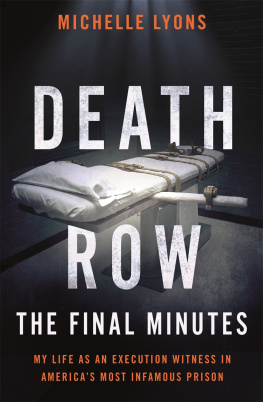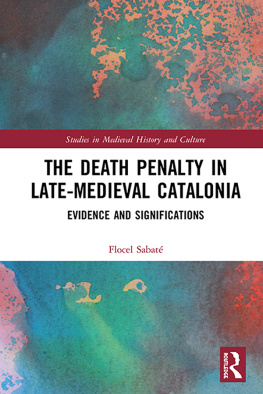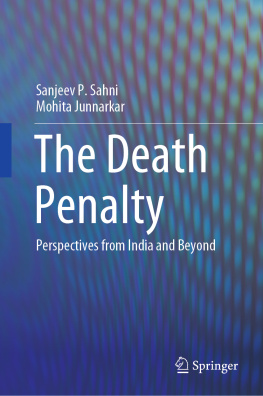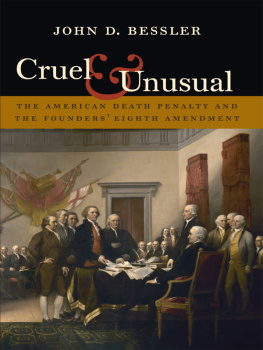GRUESOME SPECTACLES
Botched Executions and Americas Death Penalty
Austin Sarat
with
Katherine Blumstein
Aubrey Jones
Heather Richard
Madeline Sprung-Keyser
STANFORD LAW BOOKS
An Imprint of Stanford University Press
Stanford, California
Stanford University Press
Stanford, California
2014 by the Board of Trustees of the Leland Stanford Junior University. All rights reserved.
No part of this book may be reproduced or transmitted in any form or by any means, electronic or mechanical, including photocopying and recording, or in any information storage or retrieval system without the prior written permission of Stanford University Press.
Sarat, Austin, author.
Gruesome spectacles : botched executions and Americas death penalty / Austin Sarat.
pages cm
Includes bibliographical references and index.
ISBN 978-0-8047-8916-5 (cloth : alk. paper)
1. Executions and executionersUnited StatesHistory. 2. Capital punishmentUnited StatesHistory. I. Title.
HV8699.U5S268 2014
364.660973dc23
2013043599
ISBN 978-0-8047-9172-4 (electronic)
Typeset at Stanford University Press in 10.5/15 Adobe Garamond
To Ben with gratitude for his sweetness and sparkling wit
Contents
There is no law that is not inscribed on bodies. Every law has a hold on the body.... Every power, including the power of law, is written first of all on the backs of its subjects.
Michel de Certeau, The Practice of Everyday Life
Make a good job of this.
William Kemmler, first person electrocuted in the United States, 1890
Do they feel anything? Do they hurt? Is there any pain? Very humane compared to what theyve done to our children. The torture theyve put our kids through. I think sometimes its too easy. They ought to feel something. If its fire burning all the way through their body or whatever. There ought to be some little sense of pain to it.
Mother of a murder victim on being shown the planned death by lethal injection of her childs killer
People who wish to commit murder, they better not do it in the state of Florida because we may have a problem with our electric chair.
Robert Butterworth, Attorney General, State of Florida, remarking on a malfunction that caused a fire during an electrocution
Though our brother is on the rack... our sense will never inform us of what he suffers.... By the imagination we place ourselves in his situation, we conceive ourselves enduring all the same torments, we enter as it were into his body, and become in some measure the same person with him.
Adam Smith, The Theory of the Moral Sentiments
CHAPTER 1
The Mere Extinguishment of Life?
Technological Efficiency, Botched Executions, and the Legitimacy of Capital Punishment in the United States
On September 28, 1900, the state of North Carolina hanged Art Kinsauls for a murder committed in Sampson County. Born in that county in 1865, Kinsauls had lived there his entire life, marrying a local girl, Posunnie Gibsy Bass, in 1896. Even though Art weighed only 110 pounds, he was said to be tough as iron.
Kinsauls was arrested a few days after Herrings death and taken to the county jail in Clinton. With the help of a group of his friends, he soon escaped, and avoided capture for nine months. The sheriff and a posse only recaptured him after a gunfight at his farm, which left him seriously wounded. Brought to trial in October 1899, Kinsauls was found guilty of murder and was sentenced to hang.
On the surface at least, there was nothing remarkable about North Carolinas plan for the Kinsauls execution. Hanging had been the primary method of execution in the United States since the founding of the American colonies. It was an inexpensive, low-tech way of putting people to death. Hangings could be handled at the local level, and did not require elaborate execution protocols.
Kinsauls refused to go quietly. He tried to kill himself twice, first with an overdose of sleeping pills and later by using a tin lid to cut his throat. Both attempts failed, but each resulted in a postponement of his execution. In the meantime, North Carolina governor Daniel Russell received many requests for a reprieve from influential Sampson County citizens, each of which the governor refused.
On the day of the hanging, hundreds of people traveled from all over the county to witness it. The gallows was erected near the jail where Kinsauls had originally been held. As in all its executions, Sampson County used a stepladder as its gallows, but in this instance it failed to do its job. The drop height proved insufficient to break the condemneds neck. With Kinsauls suspended at the end of the rope, the attending physician quickly determined that he was still alive.
Compounding the problem was the fact that his neck had only partially healed from his last suicide attempt. As a result, when Kinsauls fell from the stepladder, the rope ripped open his neck wound and left him bleeding profusely. The assembled crowd of friends and neighbors nearly rioted. Undaunted by the failure of their first execution attempt and the increasingly chaotic, bloody scene, officials cut him down, forced him up the ladder again, and repeated the drop. This time the execution succeeded and Kinsauls died. His was the last public hanging in Sampson County.
Newspapers all over the country took note of the Kinsauls execution. Headlines in the Atlanta Constitution, the New York Times, the Washington Post, and the Republic (St. Louis, Missouri) announced that it had not gone as planned. For example, the Washington Post titled its article Murderer Hanged Twice. and the Virginian Pilot called it a thoroughly revolting execution.
Almost a century later, in March 1997, American newspapers carried stories of another botched executionthe electrocution of Pedro Medina, a thirty-nine-year-old Cuban immigrant convicted and condemned for stabbing a Florida high school teacher to death.
Yet news reports also conveyed the reassuring reaction of Dr. Belle Almojera, medical director at Florida State Prison, who said that before the apparatus caught fire Medina already had lurched up in his seat and balled up his fiststhe normal reaction to high voltage.... I saw no evidence of pain or suffering by the inmate throughout the entire process. In my professional opinion, he died a very quick, humane death.
Despite these attempts to contain adverse public reaction, the Medina execution, like the Kinsauls execution before it, made headlines because it suggested that the quest for a painless, and allegedly humane, technology of death was by no means complete. Both botched executions remind us of the ferocity of the states sovereign power over life itself. At the same time, these news stories also offered capital punishments supporters a hint of relief. Most stories treated Medinas electrocution as a mere technological glitch rather than as an occasion to rethink the practice of state killing itself. Floridas Fort Lauderdale Sun-Sentinel opined, for example, that the state is justified in imposing the death penalty.... But it has no justification for retaining a method... that is so gruesome and violent and sometimes flawed. What might have been a challenge to the legitimacy of the killing state was quickly written off as Floridas failure to keep up with the technology of the times.
Botched executions, like those of Kinsauls and Medina, have been, and remain, an important part of the story of capital punishment in the United States. From the beginning, American execution practices Executions, in this system, are not supposed to make headlines.
Headlines today tell of a remarkable transformation in Americas death penalty. Over the course of the last decade, death sentences and executions have both fallen dramatically.to ensure that execution is nothing more than the mere extinguishment of life.
Next page









